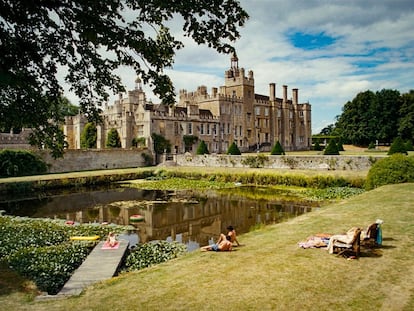From the murder of John Lennon to rejecting Antonio Banderas: How the Dakota became more famous than its inhabitants
A century and a half after its inauguration, this neo-Gothic icon of New York luxury architecture continues to make headlines. The last celebrity to abandon it was Yoko Ono

In Ira Levin’s novel Rosemary’s Baby, about a young woman who may be pregnant with Satan’s child, when the protagonist Rosemary tells a friend that she intends to move into an apartment in the Bramford building, her friend is aghast. She tells Rosemary a gruesome anecdote that includes episodes of murder, cannibalism, and witchcraft. If Rosemary is determined to be seduced by the nineteenth-century splendor of Manhattan, her friend comes to tell her, there are less foolish options. “Better go to the Dakota,” she suggests. Rosemary doesn’t follow the advice, and that’s where her problems begin.
However, it is the Dakota and not the fictitious Bramford that is the property that would be forever associated with Rosemary’s Baby, because Roman Polanski shot part of his successful adaptation of the book there in 1968. The Dakota Building, the Dakota Apartments, or simply the Dakota, is one of the architectural icons of New York. It was always thought to be the model chosen by Levin for his novel. However, the writer’s son, Nicholas Levin, has pointed out that his main inspiration actually came from Alwyn Court nearby. But the Dakota was older, more famous, and more spectacular, making it ideal as a film location.
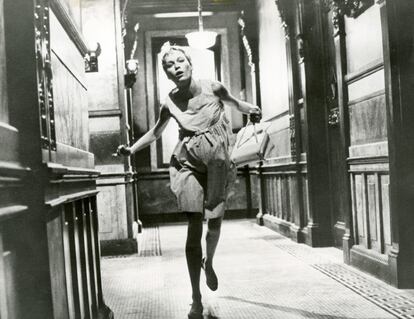
On the other hand, it should be noted that most of the scenes in the film, including all the interiors of the disturbing condominium, were filmed at the Paramount studios in Hollywood, on sets designed by production director Richard Sylbert. The audience assumes that those apartments with long corridors and large rooms, whose walls seem to radiate some evil energy, are authentic. But only a few views of the façade, the courtyard, and other common areas were shot in the Dakota itself.
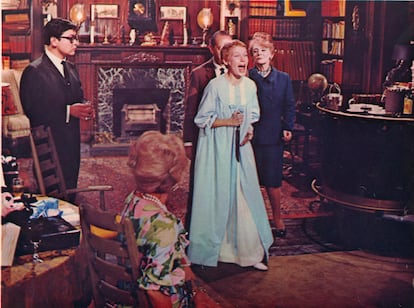
As soon as Rosemary (Mia Farrow) sees that stately apartment for rent, she is fascinated and insists to her husband, Guy (John Cassavetes), that they keep it. Once her wish has been granted, she decides to add a touch of light, painting the walls white and decorating the apartment with the cheerful tones that could be expected of a young and dynamic American couple in the mid-sixties.
In contrast, the house of their elderly neighbors, the solicitous — if somewhat meddlesome — Roman and Minnie Castevet, maintains a solemn interior design. Its heavy cabinetry furniture and dark paneling make it a perfect setting to host all kinds of covens and satanic invocations.
As it is said somewhat conventionally, the Dakota becomes another character in the story, and it is where the terrible suspicions that assail Rosemary as her pregnancy progresses begin to crystallize.
The Dakota is surrounded by a legend that includes the usual repertoire of haunted house events. There are spectral apparitions, noises of unknown origin, objects that move, elevators that go up and down by themselves. But it would be too much to foist onto the Dakota the gloomy associations that Rosemary’s friend attributed to the fictitious Bramford.
The truth is that the most disastrous event that its walls have seen occurred long after the publication of the novel and the premiere of the film. It was around 10:50 p.m. on December 8, 1980, when singer and songwriter John Lennon, a resident of the building, was shot dead at the door by a fan with mental health problems. Mark David Chapman had asked Lennon to sign an autograph a few hours earlier in the same place. This did not prevent the artist Yoko Ono, Lennon’s wife and witness to the murder, from continuing to reside in the Dakota until last summer, when she announced that she was moving to a farm in the country.
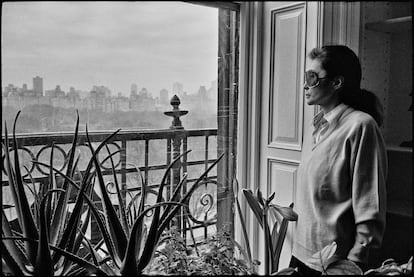
Since 1961, the residents have owned the building as a cooperative, which means that they have the right to admit or reject the applications of new residents. The list of historical occupants is especially crowded with film stars. Past and present residents include Lauren Bacall, Judy Garland, Judy Hollyday, Jack Palance, Rosie O’Donnell, Lillian Gish, José Ferrer, and Boris Karloff (it cannot be ruled out that the protagonist of Frankenstein will contribute something to the mournful fame of the house). But the list of famous residents also features the dancer Rudolf Nureyev, the playwright William Inge, the musician Leonard Bernstein, and the singer-songwriters Roberta Flack and Paul Simon. And almost as rarified is the list of those whose applications were rejected, such as Madonna, Cher, Billy Joel, Judd Apatow, and Melanie Griffith and Antonio Banderas when they were a couple.
When the Dakota was conceived, back in the last quarter of the 19th century, the idea of living in an apartment block was not very attractive to New York’s social elite. Contrary to what happened in European capitals such as Paris, Rome, London, and Madrid, apartments were reserved almost exclusively for the working classes. They were crammed into tenements next to the elevated train tracks, while the “well-off people” only considered it decent to occupy the single-family homes that still spread throughout the center of the city. The Age of Innocence (novel by Edith Wharton and film adaptation by Martin Scorsese) and the television series The Gilded Age have portrayed that period of New York’s history focusing exclusively on its most privileged sectors.
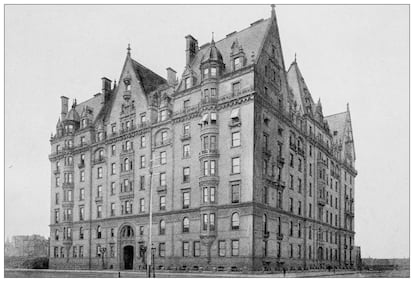
That was also the time when the first apartments aimed at the middle and upper classes were built, such as the Stuyvesant or the Spanish Flats built by Spanish businessman Juan Navarro, which were demolished during the 20th century. The magnate Edward Cabot Clark also saw a business opportunity there. Thinking that it might be difficult to convince the upper echelons of the economic aristocracy of the benefits of condominium housing, he set his sights on exploiting the growing upper middle class just below them.
Clark had amassed a large fortune through his association with Isaac Merritt Singer, founder of the Singer sewing machine manufacturing company, and as its president. And he set out to increase that wealth by entering the real estate development business. To do this, he acquired a plot of land on the Upper West Side of Manhattan, on the west side of Central Park. It was not a risk-free decision. At the time, the area was not a very attractive enclave for the bourgeoisie who were unwilling to leave their homes on Fifth Avenue and its surroundings.
Although there is no certainty about the reasons why the building was named the Dakota, it is believed that it was due to its location in the city, which was perceived as somewhat remote at that time. It was, in any case, a name that was both familiar and exotic, with resonances of territory to be conquered. This principle ended up becoming customary in the neighborhood, with later buildings being named the Nevada, the Montana, the Yosemite, and the Wyoming.
To design what began to be known by the alternative name of Clark’s folly, the businessman hired the young architect Henry Janeway Hardenbergh, who had just designed the Vancorlear, the first apartment hotel in the city. Construction lasted from 1880 to 1884, and Clark died two years before its completion. He was unable to witness the success of his folly, which was soon filled with businessmen, bankers, stockbrokers, and other prominent professionals who fit the target profile he had envisioned. All of them had been attracted by the architecture, which was essentially a souped-up version of the Vanderbilt and Astor mansions, in other words, the top tiers of that society’s aspirational pyramid.

With nine floors and 65 apartments, each consisting of between 4 and 20 rooms, the Dakota radiates the energy of a majestic mass. Its style mixes the Gothic revival with the French, and German Renaissance, in a typical pastiche of the residential power architecture of the time. On its brick façade, the vertical lines of bay windows, the terracotta finishes, the elegant cornice, the upper metal balustrade and the imposing mansards are the stand-out features. But most impressive of all is the 20-foot double arch of the main entrance, which gives access to the H-shaped interior courtyard through which provides access to the different homes. There is a second, more modest entrance, initially planned for the servants, which today remains closed except to evacuate the bodies of the deceased. It is known grimly as “the door to the funeral home,” and it is said to open once a year.
For the rest, four elevators were originally installed for the residents and the same number for the servants — the elevators were then a luxury element — the stairs were made of wrought bronze, in the courtyard there were two stone fountains with metal decorations in the shape of coves that threw water, the common areas were covered with marble and fine woods, the homes had a generous profusion of fireplaces, and common rooms were planned such as a ballroom, a dining room, kitchens from which to order meals, a laundry, and the building’s own telegraph office.
It would be in the middle of the 20th century when the Dakota began to gain popularity among celebrities, who succeeded the more conventional bourgeoisie of its beginnings. But, perhaps traumatized by the murder of John Lennon, the neighbors later changed their strategy. When in 2005 they prevented the sale of one of the apartments to Griffith and Banderas, its owner, documentary filmmaker Albert Maysles, publicly lamented that that community was moving away from creative profiles to favor of other types of wealthy people. In the following years there have also been no shortage of accusations of racism, although in 2015 a court ruling dismissing one such case.
Less popular than in other times, the Dakota still retains its legendary aura. And the extravagant glamour of having welcomed the cradle of the Antichrist.
Sign up for our weekly newsletter to get more English-language news coverage from EL PAÍS USA Edition
Tu suscripción se está usando en otro dispositivo
¿Quieres añadir otro usuario a tu suscripción?
Si continúas leyendo en este dispositivo, no se podrá leer en el otro.
FlechaTu suscripción se está usando en otro dispositivo y solo puedes acceder a EL PAÍS desde un dispositivo a la vez.
Si quieres compartir tu cuenta, cambia tu suscripción a la modalidad Premium, así podrás añadir otro usuario. Cada uno accederá con su propia cuenta de email, lo que os permitirá personalizar vuestra experiencia en EL PAÍS.
¿Tienes una suscripción de empresa? Accede aquí para contratar más cuentas.
En el caso de no saber quién está usando tu cuenta, te recomendamos cambiar tu contraseña aquí.
Si decides continuar compartiendo tu cuenta, este mensaje se mostrará en tu dispositivo y en el de la otra persona que está usando tu cuenta de forma indefinida, afectando a tu experiencia de lectura. Puedes consultar aquí los términos y condiciones de la suscripción digital.
More information
Archived In
Últimas noticias
Welcome to the post-religion era: The idea of Christianity as the absolute truth has become obsolete
‘I thought you would like it’: The risky sexual practice popularized by TV shows and TikTok
The digitalization of tourism: ‘They promise experiences and gave us the worst possible one’
Mexican peso defies uncertainty with forecasts of a new period of stability in 2026
Most viewed
- Sinaloa Cartel war is taking its toll on Los Chapitos
- Oona Chaplin: ‘I told James Cameron that I was living in a treehouse and starting a permaculture project with a friend’
- Reinhard Genzel, Nobel laureate in physics: ‘One-minute videos will never give you the truth’
- Why the price of coffee has skyrocketed: from Brazilian plantations to specialty coffee houses
- Silver prices are going crazy: This is what’s fueling the rally

